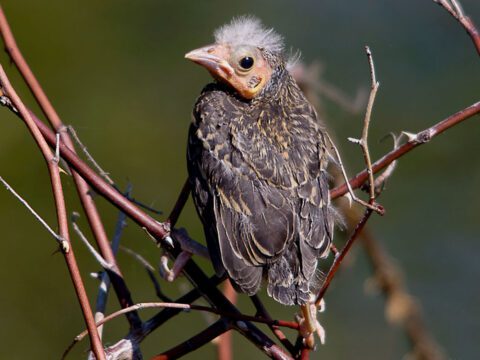Toucans Use Enormous Bills to Cool Off
July 24, 2009Not everyone who vacations in the tropics is a bird watcher – but everyone knows a toucan when they see one. Their bills approach the unbelievable: great, mango-colored scimitars that sometimes seem nearly as long as the bird itself. And yet, when I’ve seen toucans, I’ve always been amazed at how generally tiny are the fruits they eat. Toucans seem to have the dexterity of a surgeon as they pry out pea-sized fruits one by one and toss them back into their mouths.
Scientists who wonder about the reason for the toucan’s behemoth bill have noticed this, too. The birds’ food doesn’t seem to require such heavy equipment. So perhaps it’s due to the fact that other toucans find large bills irresistible. That’s the same kind of explanation that’s been used for peacock’s tails, the ridiculous prancing of sage-grouse, and any number of other exaggerated body parts and behaviors.
Or maybe it’s something no one’s thought of before. Perhaps the bill offers a nifty way for a toucan to cool off in the sultry Amazonian heat. That idea occurred to Glenn Tattersall of Brock University in Canada and colleagues at the Universidade Estadual Paulista in Sao Paulo, Brazil. After all, elephants, kit foxes, jackrabbits, and many other animals of hot regions cool their blood by circulating it through oversized ears, using them like a car’s radiator. Why couldn’t toucans be doing something similar with their bills?
That reasoning prompted Tattersall and colleagues to sit a Toco Toucan in front of an infrared camera at sunset and watch it go to sleep. The camera detected heat streaming out of the bill, which was a full 10 to 15 degrees Celsius warmer than the surrounding air and much warmer than the rest of its body. What’s more, the scientists noticed that the bill warmed and cooled slightly as the bird prepared for sleep, and then slowly cooled down to match the air temperature as the toucan slept (you can see this happening in the last half of the video, above). The researchers took this as evidence that the toucan regulates how much blood it sends into the bill, and thereby controls how much its body cools down or warms up.
It’s not the final answer to why the toucan’s bill is so large, Tattersall said. But the new finding does provide evidence that the bill can help the bird keep its temperature under control – and it’s not soley a fashion statement. The work appears today in the journal Science.
Time-lapse video courtesy Glenn Tattersall, Brock University.

All About Birds
is a free resource
Available for everyone,
funded by donors like you
American Kestrel by Blair Dudeck / Macaulay Library


